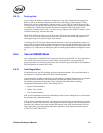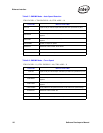
Software Developer’s Manual 161
Ethernet Interface
A set of registers is provided to facilitate either hardware or software Auto-Negotiation.
The hardware supports both hardware and software Auto-Negotiation methods for determining
link configuration as well as allowing for manual configuration to force the link. The IEEE 802.3z
specification defines a set of resources that software can use to control a hardware implementation
of Auto-Negotiation, but this definition is sub-optimal for Internal Serdes mode (TBI mode for the
82544GC/EI) and hardware Auto-Negotiation is the preferred method.
In addition, it specifies optional resources that exist only to support the exchange of “Next Pages”,
something that is not required for the Ethernet controller. The hardware defined in this
specification accepts and exchanges next pages in Internal Serdes mode (TBI mode for the
82544GC/EI), but does so by dropping all incoming next pages and sending only null next pages.
The Ethernet controller can only send null next pages when in hardware Auto-Negotiation. A full
next page exchange can take place if software performs Auto-Negotiation.
The Ethernet controller fully complies with IEEE 802.3z with respect to next page exchange in that
both link partners must request next page exchange in order to do so.
8.6.1.3 Hardware Auto-Negotiation
Hardware supports negotiation of the link configuration per clause 37 of the 802.3z standard. This
is accomplished by the exchange of /C/ ordered sets that contain the txConfigWord register values
from TXCW in the third and fourth symbols of the ordered sets.
Bits FD and LU of the Device Status register (STATUS), and ANC of the RXCW register provide
status information regarding the negotiated link.
Auto-Negotiation can be initiated by the following:
• LRST transition from 1b to 0b in CTRL register
• ANE transition from 0b to 1b in TXCW register
• Receipt of /C/ ordered set during normal operation
• Receipt of different value of the /C/ ordered set during the negotiation process
• Transition from loss of synchronization to synchronized state (if ANE is enabled)
Resolution of the negotiated link determines device operation with respect to flow control
capability and duplex settings. These negotiated capabilities override advertised and S/W
controlled device configuration.
Software must configure the
TXCW.txConfigWord field to the desired advertised base page. The
bits in the Device Control register are not mapped to the
txConfigWord field in hardware until after
Auto-Negotiation completes. The Figure 8-2 and Figure 8-3 show txConfigWord and the mapping
to the Config_reg Base Page encoding per clause 37 of the standard. Table 8-2 lists the bit contents.
Figure 8-2. TXCW.txConfigWord
1514131211109876543210
Np
RS
V
RS
V
RS
V
RS
V
RS
V
RS
V
AS PS Hd Fd
RS
V
RS
V
RS
V
RS
V
RS
V
1514131211109876543210
Np Ack Rf2 Rf1
RS
V
RS
V
RS
V
Ps2 Ps1 Hd Fd
RS
V
RS
V
RS
V
RS
V
RS
V


















